Who is the blogger?
Archived entry
Rebel Without a Cause (1955) and September 30, 1955 (1977)
"Live Fast, Die Young"
(attributed to Jimmy Dean)
James Dean's unforgettable performance in "Rebel without a Cause" is memorialized by Richard Thomas in the retrospective look at life in the 1950's, "September 30, 1955". Both movies deal with youth and alienation. Dean's legend lives on in film and in the popular imagination.
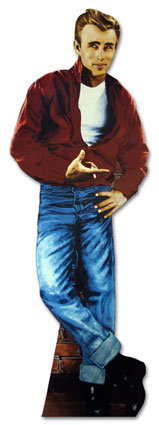 At Dawson College in Montréal on September 13th, 2006, a young man named Kimveer Gill, went on a shooting spree. He killed one young woman, Anastasia DeSousa, and critically injured several others. The gunman killed himself when confronted by police after wounding 19 students at the CEGEP. Gill used a registered gun in the shooting. He had no connection to the school, no recorded history of mental illness, no criminal record. It was apparently a random act of violence. No indicators have been found as to why Gill turned violent. There are no indicators that is, until you read his blog on VampireFreaks.com, a site for young Goths.
At Dawson College in Montréal on September 13th, 2006, a young man named Kimveer Gill, went on a shooting spree. He killed one young woman, Anastasia DeSousa, and critically injured several others. The gunman killed himself when confronted by police after wounding 19 students at the CEGEP. Gill used a registered gun in the shooting. He had no connection to the school, no recorded history of mental illness, no criminal record. It was apparently a random act of violence. No indicators have been found as to why Gill turned violent. There are no indicators that is, until you read his blog on VampireFreaks.com, a site for young Goths.
Gill used the online handle "fatality666". In his posts, he talked about what he had for breakfast, his love life, the violent video games he played, and the fact that he loved guns. Gill’s blog also revealed his sense of profound alienation from and hatred toward the rest of mankind. He also quoted James Dean for an inscription for his tombstone: "Lived fast. Died young. . . ." (See Dean's biography for the real source of the quote)
The two movies shown in past episodes on Saturday Night at the Movies, Rebel Without a Cause and September 30, 1955 look at alienation in youth culture. Jimmy Dean was an icon of rebellious youth. The movies are a retrospective look at how that image was first generated and how the legend was then maintained.
Rebel Without a Cause and September 30, 1955 both have in common the fact that the director wrote the story for the film. Nicholas Ray, Rebel’s director, came up with the story. Ray even did “personal research” by riding around at night with L.A. gangs to get a feel for what was going on. The title was retained from a non-fiction work for which the studio had bought the rights and the story became fictionalized through an adaptation process before being translated for film by a screenwriter.
September 30th is actually a semi-autobiographical story by the director, James Bridges, who becomes the Jimmy J. character (Richard Thomas) in the film. Bridges attempts to capture the atmosphere, the people and the events that related to his own late adolescence including his personal idolization of the actor, James Dean.
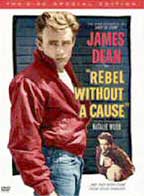 I don’t quite know how to say it, but I was a little disappointed when I first saw Rebel Without a Cause. I found it to be somewhat hokey. I’m not altogether sure why. Maybe I had built up vast expectations in my mind. Maybe the 1950’s psychologizing aspect was too close to sermonizing for my taste. I don’t know. I do know that I appreciated the movie more the second time around.
I don’t quite know how to say it, but I was a little disappointed when I first saw Rebel Without a Cause. I found it to be somewhat hokey. I’m not altogether sure why. Maybe I had built up vast expectations in my mind. Maybe the 1950’s psychologizing aspect was too close to sermonizing for my taste. I don’t know. I do know that I appreciated the movie more the second time around.
For a movie called “Rebel Without a Cause”, the film’s approach devoted much attention to carefully underscoring the “causes for rebellion” in the three main adolescent characters. These being adolescents from middle class suburbia, the existence of teenage rebellion must have seemed like a much more perplexing and indeed troubling phenomenon for parents and society in general in the 1950s. This being an era of unsurpassed peace and prosperity in America, the most obvious culprits are obviously not to blame (poverty, disenfranchisement, war, social upheaval . . .). How could such “nice, normal” middle class kids get involved so quickly in socially maladjusted hooliganism and destructive violence?
It seems to me that in answering these questions, Nicholas Ray goes in a couple of directions. There is the inward exploration through psychological analysis of people and events and there is the upward exploration of the overarching metanarrative.
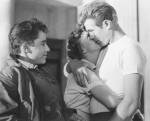 For ‘Plato’, played by Sal Mineo, the blatant neglect and emotional aloofness of his divorced parents emerges as the reason for his disconnect from normal society and ultimately from reality as he descends into fear and paranoia. Plato just wants to belong. He attaches himself to Jim as a friend and a kind of a father figure.
For ‘Plato’, played by Sal Mineo, the blatant neglect and emotional aloofness of his divorced parents emerges as the reason for his disconnect from normal society and ultimately from reality as he descends into fear and paranoia. Plato just wants to belong. He attaches himself to Jim as a friend and a kind of a father figure.
Judy (Natalie Wood) uses her budding sexuality to create meaning and a sense of belonging for herself. Scenes where her father rebuffs her affectionate kisses (“You’re too old for that kind of thing now!” her dad barks) are supposed to “explain” Judy’s involvement in the gang. Since Judy has problems finding validation and acceptance, including acceptance of her emerging sexuality, at home, she finds it elsewhere. She becomes the gang leader’s girlfriend. Later, she experiences “real love” for the first time by belonging to fellow outsider, Jim Stark.
 Jim Stark as realized by Jimmy Dean is a young man who has problems communicating with his parents, people who obviously have problems of their own. Jim uses alcohol to try to cope with his inward confusion and turmoil. His parents use social mobility (moving from town to town) to try to cover up and cope with their son’s problems. Jim’s desperate attempts to try to talk to his parents end in frustration. Jim gives up, blockaded by his mom’s evasion of the truth and steadfast commitment to superficiality and appearances. He finds it impossible to connect with a father who wears an apron and refuses to “stand up” to his wife’s henpecking. Even though they are trying to be good parents, Jim doesn’t find what he needs at home.
Jim Stark as realized by Jimmy Dean is a young man who has problems communicating with his parents, people who obviously have problems of their own. Jim uses alcohol to try to cope with his inward confusion and turmoil. His parents use social mobility (moving from town to town) to try to cover up and cope with their son’s problems. Jim’s desperate attempts to try to talk to his parents end in frustration. Jim gives up, blockaded by his mom’s evasion of the truth and steadfast commitment to superficiality and appearances. He finds it impossible to connect with a father who wears an apron and refuses to “stand up” to his wife’s henpecking. Even though they are trying to be good parents, Jim doesn’t find what he needs at home.
It’s all very Freudian.
And then there is the trip to the planetarium. More than just a mere school outing, the monologue supplied to the high school students about the universe during the presentation at the planetarium also provides the filmmakers with the opportunity to pull out modernism’s reigning metanarrative for inspection. Naturalism’s ultimate answer for “who we really are as human beings and where we fit in in the grand scheme of things” is touted as the great wisdom that modern science has to offer. Kids struggling with issues of personal identity, purpose, and belonging sit in a vast, darkened hall learning that humanity is alone in the universe. A disembodied voice of authority tells them that as to our origins, all is a cosmic accident and that the universe will end long after the human race has exited the scene after its brief and meaningless stay on an insignificant planet. Cold comfort that.
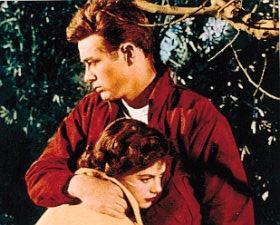 As I said, the second time around with “Rebel”, I enjoyed it more. I was able to focus more on details. There were details like the opening credits with the virtuosity of James Dean’s improv performance with the toy monkey while lying drunk and disorderly on the sidewalk - Details such as the redness of Judy’s coat and matching lipstick that she carefully paints on at the police station. Is Judy making a statement about rebellion through a flaunted sexuality, or is she merely a young girl caught up in the latest fashion trends, or both? Plato’s socks don’t match. So what? The socks become the brunt of a juvenile joke at Plato’s expense. They also reflect the painful state of inner confusion for Plato over everything from who his parents are to who his friends are to who he is (there are hints of Plato’s confusion over his sexual orientation).
As I said, the second time around with “Rebel”, I enjoyed it more. I was able to focus more on details. There were details like the opening credits with the virtuosity of James Dean’s improv performance with the toy monkey while lying drunk and disorderly on the sidewalk - Details such as the redness of Judy’s coat and matching lipstick that she carefully paints on at the police station. Is Judy making a statement about rebellion through a flaunted sexuality, or is she merely a young girl caught up in the latest fashion trends, or both? Plato’s socks don’t match. So what? The socks become the brunt of a juvenile joke at Plato’s expense. They also reflect the painful state of inner confusion for Plato over everything from who his parents are to who his friends are to who he is (there are hints of Plato’s confusion over his sexual orientation).I appreciated more the quality of some of the acting, including that of James Dean. I also appreciated how certain visual aspects were used. Some of Dean’s lines are pitched from a cockeyed camera angle, evoking the skewed and disjointed perspective of the restless teen. The film starts with a claustrophobically close-up shot of Jimmy Dean and the toy monkey on the ground and ends with a wide-angled zoom out of the planetarium from the air. It’s as if you can only take such an intensely scrutinized look at the egocentric world of the teens for so long. Then you have to glance away to a wider viewpoint.
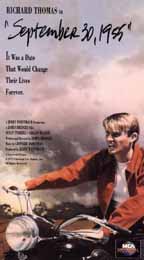 Life lived with intensity and turmoil – That pretty much describes September 30, 1955. It was a film I only saw once and am likely to see only once, given that it is not a particularly famous film. This was another midnight movie where I kept saying to myself, “Now be reasonable, self. You just have to get to bed!” Thank goodness that I decided not to listen to the Voice of Reason. I might have missed a very compelling performance by Richard Thomas and a very interesting take on youth culture as it existed in the 1950’s.
Life lived with intensity and turmoil – That pretty much describes September 30, 1955. It was a film I only saw once and am likely to see only once, given that it is not a particularly famous film. This was another midnight movie where I kept saying to myself, “Now be reasonable, self. You just have to get to bed!” Thank goodness that I decided not to listen to the Voice of Reason. I might have missed a very compelling performance by Richard Thomas and a very interesting take on youth culture as it existed in the 1950’s.
The “Leave it to Beaver” mentality had definitely left the studio lot by the time this film was shot in 1977. James Bridges gives us a fair and honest treatment of issues affecting teens: social conformity and individual independence, social acceptance and social rejection, experimentation with sex and lots of confusion surrounding sex, the collision of idealism and reality, communication and the generation gap. Bridges shows us that, unlike the world we saw in “Leave it to Beaver”, all that stuff was there in the 1950’s just as it is there today.
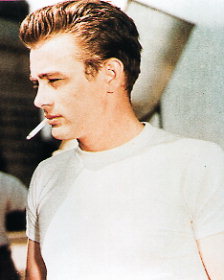 Jimmy J. is passionately caught up with the idea of going out to Hollywood to somehow connect with his dead idol, James Dean. Jimmy J.’s encounter with the onscreen Dean has been a revelation that somehow gives voice to his passions and meaning to his life. Dean is a hero for Jimmy, “someone who has changed my life”. Jimmy J. says, “My life is starting to feel like a movie. Nothing is real, but it (“Rebel”?) is more real than a movie.” B. J. replies, “This isn’t a movie.” Jimmy J. eventually rides off into the sunset on his new motorcycle with his red jacket in search of a new life in the steps of his hero, Jimmy Dean.
Jimmy J. is passionately caught up with the idea of going out to Hollywood to somehow connect with his dead idol, James Dean. Jimmy J.’s encounter with the onscreen Dean has been a revelation that somehow gives voice to his passions and meaning to his life. Dean is a hero for Jimmy, “someone who has changed my life”. Jimmy J. says, “My life is starting to feel like a movie. Nothing is real, but it (“Rebel”?) is more real than a movie.” B. J. replies, “This isn’t a movie.” Jimmy J. eventually rides off into the sunset on his new motorcycle with his red jacket in search of a new life in the steps of his hero, Jimmy Dean.
Youth and alienation are nothing new. Perhaps the role of the Internet and the accessibility of high powered guns were not present in 1955, but otherwise it is amazing to see how the same themes work themselves out in the onscreen tragedies of yesteryear and the real life tragedies of today's headlines.
One Blair Hagen, spokesman for the National Firearms Association, was quoted in the newspaper as saying, “I think it (the shooting at Dawson College) demonstrates that gun control has absolutely no effect. When you have a person like this who has hate in his heart, regulations and registries are not going to stand in his way.” Well, yes and no. I still think that making some co-coordinated attempt at controlling the flow of firearms is the only rational way for a civilized and democratic society to proceed in averting a culture of violence. And yes, the only way to keep people like Kimveer Gill from destroying lives is to deal successfully with the issues of the heart.
Suggested Reading:
- James Dean learned to fight with a switchblade from a cast member who was a former Hollywood street gang member. Dean and Allen (Buzz) used real switchblades during the on camera knife fight and wore chain mail under their clothes to protect themselves. Trivia from IMDb
- "Lived fast, lives on to tell about it . . . " a story of redemption : Christian Hosoi - from pro skateboarding champion, to crystal meth, to prison, to freedom (video)
- "Excuse me, people . . . Could we get an alternative metanarrative in here and see how that fits? Maybe if we tried that shot from a different angle . . . "
- Astrology, the way of power and the enlightened masters: Finding the deeper truths of life
- Got problems with an authority complex? Who's directing your life?



